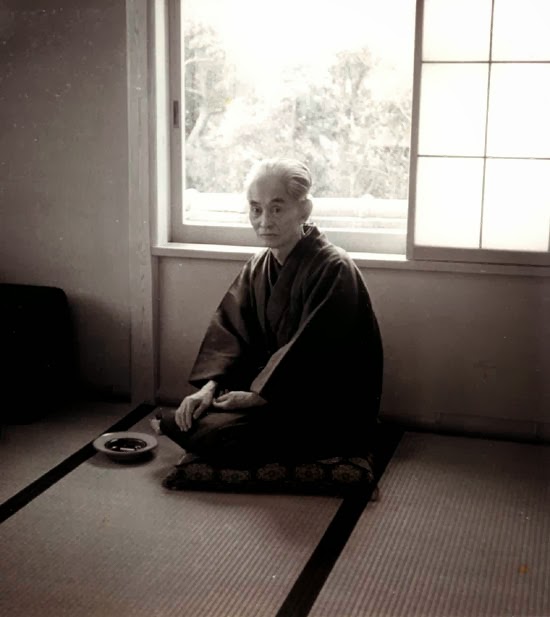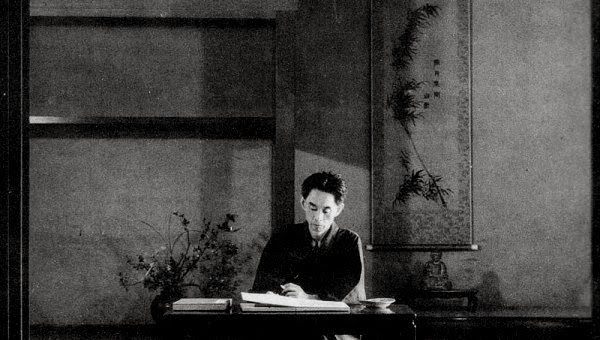caused by a little mole
The Mole Letter
by Kawabata Yasunari
“Last night I had a dream about the mole”. These are the initial words of The mole letter (黒子の手紙, Hokuro no tegami), a tale written in 1940 by Kawabata Yasunari (川端 康成, 1899 - 1972).
 Sayoko is left by her husband because she has always toyed with her shoulder’s big brown mole. In fact, he continually blamed her about that bad habit and he believes that she toys with her mole because she wants to spite him. After that, she writes a letter to him in which she apologizes and she analyses her relationship with the mole from childhood to maturity and wedding; this letter is like an inner speech, a sort of silent and painful monologue.
Sayoko is left by her husband because she has always toyed with her shoulder’s big brown mole. In fact, he continually blamed her about that bad habit and he believes that she toys with her mole because she wants to spite him. After that, she writes a letter to him in which she apologizes and she analyses her relationship with the mole from childhood to maturity and wedding; this letter is like an inner speech, a sort of silent and painful monologue.
No names are mentioned in this tale, so that the writing is more impersonal: we can all put ourselves in the wife’s shoes and her words may become our own words. In the letter she writes that when she was a child, her parents and relatives used to toy with her mole while they were bathing together in the ofuro, so that when touching her mole she feels like becoming a child again and she needs the same love from her husband. Then she eventually understands why she toyed with the mole: she only wanted to feel loved by her husband.
This is the sad end of their relationship full of resentment and misunderstandings. It cannot exist a sincere relationship between wife and husband and there is no possible communication in the couple. So that husband can not understand his wife’s real feeling, her need to be loved and be protected by him. That’s the reason why she has to write her sensations: it’s impossible to express her true feelings to him by speech because he isn't able to understand them.
 Writing the letter becomes also a treatment by which she can lighten her anguish. This marital crisis belongs not only to Japanese family but also to western families. Like in other Kawabata’s novels, in this tale there is a strong female character who dominates the plot; she is an heroine actually defeated by her own feelings. The repeated and oppressive theme of the mole touch makes the reader be pressed and almost hypnotized by it; the mole becomes the symbol of all our anguishes and weaknesses. In the Japanese literature a little thing may become the main subject of writing. The mole of Sayoko is the emblem of the little and big sorrows of everyday life with its charge of unresolved regrets and hidden sincerities.
Writing the letter becomes also a treatment by which she can lighten her anguish. This marital crisis belongs not only to Japanese family but also to western families. Like in other Kawabata’s novels, in this tale there is a strong female character who dominates the plot; she is an heroine actually defeated by her own feelings. The repeated and oppressive theme of the mole touch makes the reader be pressed and almost hypnotized by it; the mole becomes the symbol of all our anguishes and weaknesses. In the Japanese literature a little thing may become the main subject of writing. The mole of Sayoko is the emblem of the little and big sorrows of everyday life with its charge of unresolved regrets and hidden sincerities.
In the end the woman can discover the lack of understanding of which is made her wedding and this sad consciousness makes her write to him: “Yet I had to tell you these words”. The tale ends with these resigned words. Husband and wife are both losers.
 Sayoko is left by her husband because she has always toyed with her shoulder’s big brown mole. In fact, he continually blamed her about that bad habit and he believes that she toys with her mole because she wants to spite him. After that, she writes a letter to him in which she apologizes and she analyses her relationship with the mole from childhood to maturity and wedding; this letter is like an inner speech, a sort of silent and painful monologue.
Sayoko is left by her husband because she has always toyed with her shoulder’s big brown mole. In fact, he continually blamed her about that bad habit and he believes that she toys with her mole because she wants to spite him. After that, she writes a letter to him in which she apologizes and she analyses her relationship with the mole from childhood to maturity and wedding; this letter is like an inner speech, a sort of silent and painful monologue. No names are mentioned in this tale, so that the writing is more impersonal: we can all put ourselves in the wife’s shoes and her words may become our own words. In the letter she writes that when she was a child, her parents and relatives used to toy with her mole while they were bathing together in the ofuro, so that when touching her mole she feels like becoming a child again and she needs the same love from her husband. Then she eventually understands why she toyed with the mole: she only wanted to feel loved by her husband.
This is the sad end of their relationship full of resentment and misunderstandings. It cannot exist a sincere relationship between wife and husband and there is no possible communication in the couple. So that husband can not understand his wife’s real feeling, her need to be loved and be protected by him. That’s the reason why she has to write her sensations: it’s impossible to express her true feelings to him by speech because he isn't able to understand them.
 Writing the letter becomes also a treatment by which she can lighten her anguish. This marital crisis belongs not only to Japanese family but also to western families. Like in other Kawabata’s novels, in this tale there is a strong female character who dominates the plot; she is an heroine actually defeated by her own feelings. The repeated and oppressive theme of the mole touch makes the reader be pressed and almost hypnotized by it; the mole becomes the symbol of all our anguishes and weaknesses. In the Japanese literature a little thing may become the main subject of writing. The mole of Sayoko is the emblem of the little and big sorrows of everyday life with its charge of unresolved regrets and hidden sincerities.
Writing the letter becomes also a treatment by which she can lighten her anguish. This marital crisis belongs not only to Japanese family but also to western families. Like in other Kawabata’s novels, in this tale there is a strong female character who dominates the plot; she is an heroine actually defeated by her own feelings. The repeated and oppressive theme of the mole touch makes the reader be pressed and almost hypnotized by it; the mole becomes the symbol of all our anguishes and weaknesses. In the Japanese literature a little thing may become the main subject of writing. The mole of Sayoko is the emblem of the little and big sorrows of everyday life with its charge of unresolved regrets and hidden sincerities. In the end the woman can discover the lack of understanding of which is made her wedding and this sad consciousness makes her write to him: “Yet I had to tell you these words”. The tale ends with these resigned words. Husband and wife are both losers.
Floriano Terrano
 妻の小夜子は夫から愛想をつかされます。それは、小夜子が彼女の肩にある黒く大きなホクロを常にいじっていたことが原因でした。夫は、妻のこの悪癖をいつも叱責していました。そして、彼女がホクロを触るのは、自分に対するいやがらせだと思い込んでいました。
妻の小夜子は夫から愛想をつかされます。それは、小夜子が彼女の肩にある黒く大きなホクロを常にいじっていたことが原因でした。夫は、妻のこの悪癖をいつも叱責していました。そして、彼女がホクロを触るのは、自分に対するいやがらせだと思い込んでいました。
 最後に遂に妻は、思いやりの欠如の上にこの結婚があることを理解し、この悲しい自覚が、彼女に夫への手紙をしたためさせるのでした。「このことをあなたにお伝えしたいものでございます」。物語は、この、観念したような言葉で終わります。夫と妻の二人ともが敗者なのでした。
最後に遂に妻は、思いやりの欠如の上にこの結婚があることを理解し、この悲しい自覚が、彼女に夫への手紙をしたためさせるのでした。「このことをあなたにお伝えしたいものでございます」。物語は、この、観念したような言葉で終わります。夫と妻の二人ともが敗者なのでした。
フロリアーノ・テッラーノ
小さなホクロが原因で迎えた夫婦間系の終焉
〜川端康成の『ほくろの手紙』〜
「黒子(ほくろ)の夢を、わたくし昨夜見ました」。これは川端康成(1899〜1972年)による1940年の短編小説、『ほくろの手紙』(※編註)の最初の一文です。
 妻の小夜子は夫から愛想をつかされます。それは、小夜子が彼女の肩にある黒く大きなホクロを常にいじっていたことが原因でした。夫は、妻のこの悪癖をいつも叱責していました。そして、彼女がホクロを触るのは、自分に対するいやがらせだと思い込んでいました。
妻の小夜子は夫から愛想をつかされます。それは、小夜子が彼女の肩にある黒く大きなホクロを常にいじっていたことが原因でした。夫は、妻のこの悪癖をいつも叱責していました。そして、彼女がホクロを触るのは、自分に対するいやがらせだと思い込んでいました。
里に帰された妻は、夫に手紙を書きます。手紙の中で小夜子は夫に詫び、そして、子供の頃から成人するまでの、そして結婚生活のあいだの、自分とそのホクロとの関係について分析し、語ります。その手紙は、心の内の会話のように、悲嘆にくれた無言の独り言のように、綴られて行くのです。
この小説には、登場人物の名前の記述がありません。このことが、この物語に、非個人的(普遍的)な性格を与えています。それ故に、どの読者もが、妻の立場に身を置くことができ、そして彼女の言葉は私たち読者自身の言葉や感覚となりうるのです。
手紙の中で小夜子は、子供の頃に両親や家族と一緒にお風呂に入った時、彼らが小夜子のホクロを触るのが常であったから、自分は今でもホクロをいじる度に、子供の時に戻ったような気持ちになり、そして彼らの愛情を再び感じられるのだと説明します。今、その同じ愛を彼女は夫に求めているのです。そう、遂に小夜子は、なぜ自分がホクロを常にいじるのかを理解します。彼女は、夫から愛されることをただただ望んでいたのでした。
これが、恨みつらみと無理解に満ちた、彼らの婚姻の悲しい結末です。二人の間で良いコミュニケーションがとれていなければ、夫と妻の誠意ある関係はありえず、その結果、夫は妻の真の情感や愛情や、彼女が夫から愛され護られることを欲していることを、理解できないのです。そしてこれが正に、小夜子が自分の気持ちを手紙にして書かなければならなかった理由なのです。夫のことに関しては自分の気持ちを小夜子は言葉にして表すことが出来ない。なぜなら夫には彼女の気持ちを理解できるだけの器がないからです。そして、小夜子にとっても、手紙に書くことによって彼女の深い苦悩を外に出してしまえる機会になったのでした。このような婚姻関係の危機は、日本人家族においてのみのものではありません。世界の全家族にありえるものです。
川端康成の他の小説と同じように、この『ほくろの手紙』においても、強い性格の女性が筋書きの展開を支配しています。小夜子は、最後に自身の感情に敗北を喫する女主人公なのです。
ホクロをいじるという、繰り返し登場する重苦しいモチーフは、読者に圧迫をかけながら、いつしか我々に恍惚感をも感じさせるようになります。ホクロが、私たちが心の内にもつ全ての苦悩と弱さのシンボルとなるのです。日本の文学においては、このようにささいな事が、物語の筋のテーマとなりえるのですが、小夜子のホクロは、日々の生活の中で消化できない悔やみや、表にあらわれない隠された真心を背負った、小さな又は大きな苦しみの象徴なのです
 最後に遂に妻は、思いやりの欠如の上にこの結婚があることを理解し、この悲しい自覚が、彼女に夫への手紙をしたためさせるのでした。「このことをあなたにお伝えしたいものでございます」。物語は、この、観念したような言葉で終わります。夫と妻の二人ともが敗者なのでした。
最後に遂に妻は、思いやりの欠如の上にこの結婚があることを理解し、この悲しい自覚が、彼女に夫への手紙をしたためさせるのでした。「このことをあなたにお伝えしたいものでございます」。物語は、この、観念したような言葉で終わります。夫と妻の二人ともが敗者なのでした。
※(編註)川端康成の「ほくろの手紙」は、昭和16年(1941年)新潮社より発行された短編小説集『愛する人達』に収録されている。初出は、昭和15年に雑誌「婦人公論」にて、やはり『愛する人達』と題された連載短編のひとつとして発表されたもの。
フロリアーノ・テッラーノ



No comments:
Post a Comment